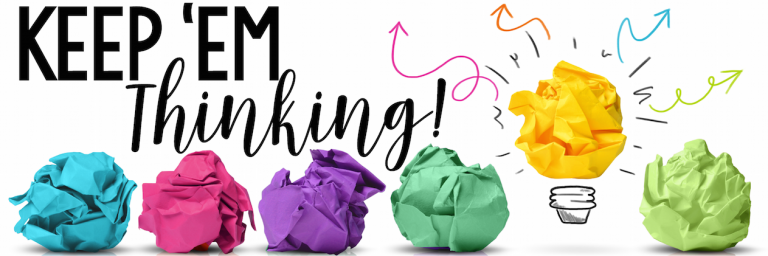

3 Creative Ideas for Teaching Biographies Your Students Will Love
There is so much power in teaching our students about history using biographies. We can all learn from the success and failures of others. But biographies often get a bad rap of being dry and boring. It doesn’t have to be that way. In fact, through this genre, our students can practice many different reading skills and strategies. That’s why I use graphic organizers that will allow my students to recall information from the biographies in creative ways. I am excited to share these 3 creative ideas for teaching biographies using fun and exciting graphic organizers I know your students will love!
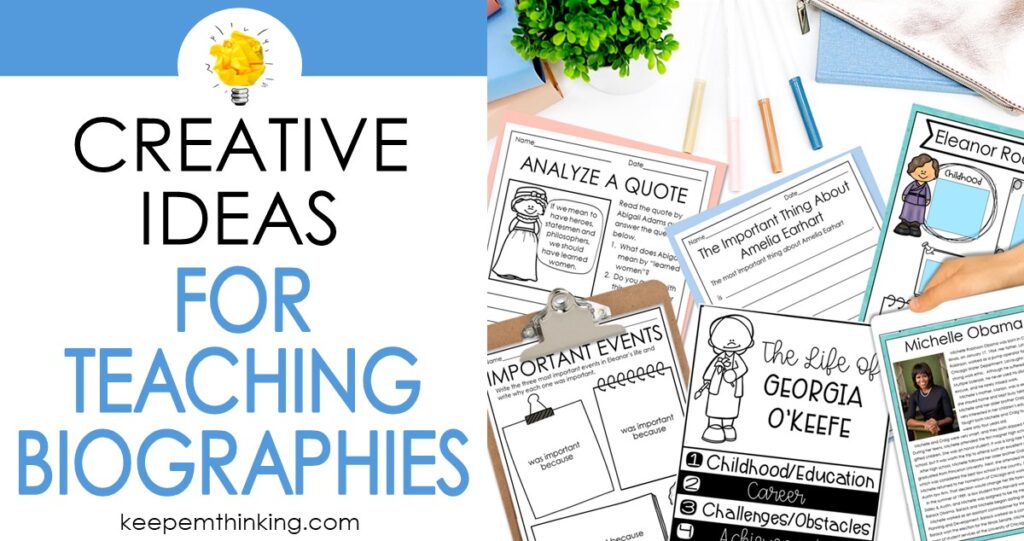
Teaching Biographies can be Exciting
When teaching biographies in my classroom I like to immerse my students into the lives of the person they are learning about. From decorating the classroom to dressing up like the person we are studying, the possibilities are endless. This really helps to “bring the person to life” and make the learning more engaging and realistic for our students.
No matter what biography you are focusing on, these 3 creative ideas for teaching biographies are going to be so fun your kids will be begging for more!
1. EXTRA! EXTRA!

Read all about it in this year’s edition of the 3rd grade Daily Times. And that’s the hook! One of my favorite ways to immerse my students into learning is to turn them all into little reporters. At the end of our biography unit, we create a newspaper. It includes articles about each of the people of influence we focused on. I can’t tell you how excited my students get when they hear they will be writing and “publishing” a newspaper!
I like to put students in groups of 3 or 4. Then, give each one a person they will be focusing on. As a group, they must choose graphic organizers to will help them record information about their person. They can read an article that I provide, get information from a book, or research the person on a safe search site.
After reading the information about their person, they use the graphic organizers they chose to record important information about the person. This is the “interview” for the article.
Pulling it all Together
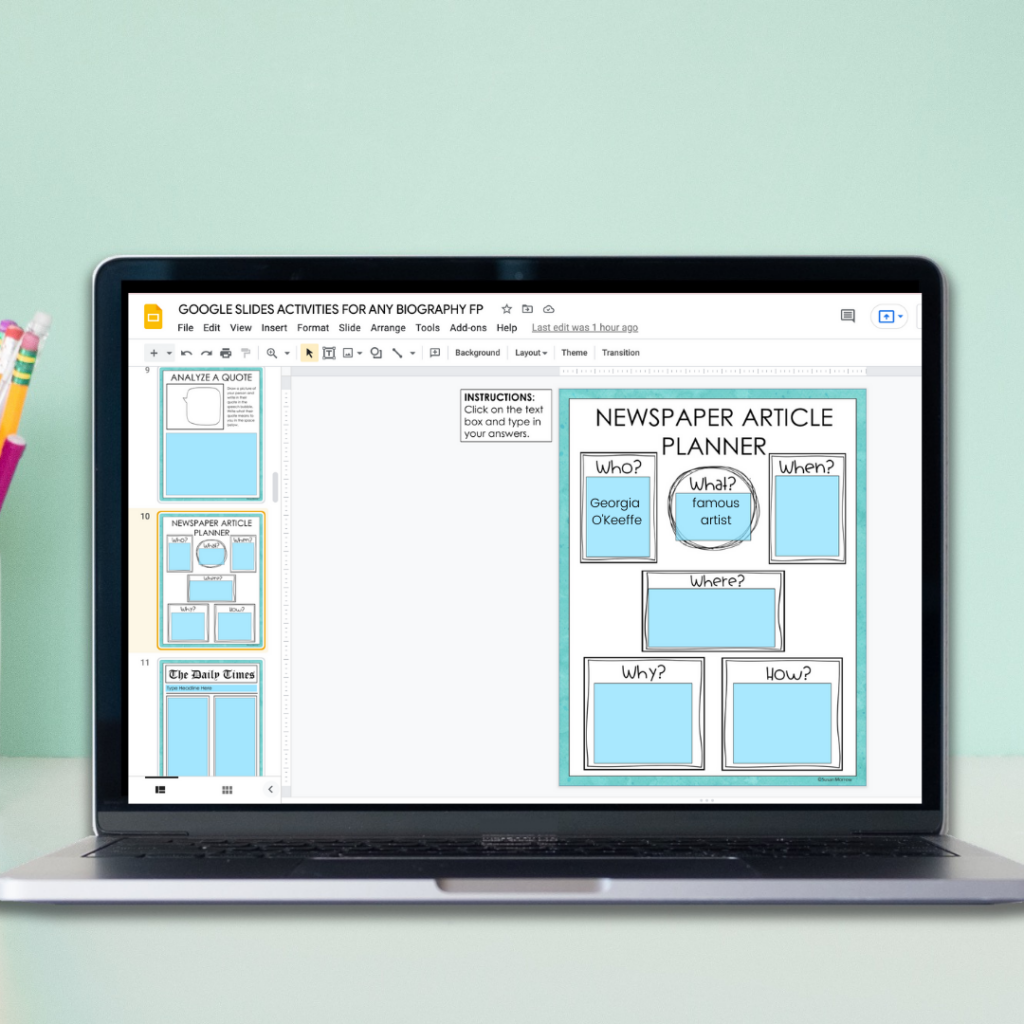
Next, it’s time to put the information from the graphic organizers all together. They will write all of the information in one article that will be included in our newspaper. The newspaper can be tangible if you want your students to assemble it and include their own drawings. But, it can also be digital with each group focusing on specific slides. This can then be projected on a whiteboard or viewed on a tablet or computer.
Not only is it a great way for students to learn from informative text, but it also gives you a fun and easy way to assess their learning. Sharing the newspaper in the school library is sure to be a hit. Teachers or librarians can read the newspaper articles to classes when they visit the library. So cool!
This really is such a great way for me to teach biographies in an easy way my students love!

2. The Life and Times…
This is a fun timeline activity that begs to be interactive! When teaching biographies, I love to use timelines because it gives students a concrete visual of when key events took place. This helps students better able to identify with the life of the person they are studying.

For example, if we are focusing on Amelia Earheart, I create a huge timeline that goes around my classroom. We start at the beginning and focus each day on an aspect of her life. We add information to the timeline as we go, and this is where those awesome graphic organizers come into play.
With a cause and effect graphic organizer, I can ask my students to think critically about events in the life of Amelia Earheart. Then we can discuss how those events shaped her future. As we learn about other things that are happening in the world, we can add those to the timeline as well.

I can’t tell you how awesome it is to get those “lightbulb” moments! I love when students make connections between world events and the person they are studying.
The end of our timeline activity concludes with a flipbook with all the information we have learned about Amelia Earheart. My kids really love this activity because they are allowed to get up and walk around. They take their clipboards to make notes from the timeline to help them complete the information for the flipbook. It’s a great way for them to show off their learning when they take it home.
3. Pick a Person
This is a really fun way to build excitement when teaching biographies. I put the names of all the people I want my students to choose from when working on their biographies. Then, after arranging my class into 4 or 5 groups, it’s time for the choosing ceremony. Each team gets to reach inside a basket and draw the name of a person. This will be the person they will be responsible for reporting on at the end of the unit.

Next, each group has to do some research on the person of influence they will be focusing on. This could mean a special trip to the library for the group to check out a book, some safe search research on the computer, or even a look through our biographies section of our class book boxes. I think this is a great way to give your students a little independence and responsibility they will be overjoyed to get.
Graphic organizers are so great for biographies because there is so much information available out there. It can feel overwhelming for kids to try to organize their thoughts and recall important facts and details about the lives of the people we are studying. They are a great way to get our students to really focus on what’s important and what they want to include in their presentations.
The Presentations

Now, it’s time for the really fun part! I give my students some time to think about how they could present their information to the class. Some groups like to use technology and create a video slideshow, a recorded skit, or even a self-made news clip featuring their famous person. Other groups may want to get creative and make a poster with visual images representing the information they learned about the person they are focusing on.
If a free choice scenario isn’t your cup of tea, consider making a list of presentation options you would be comfortable with. By giving students some choice in their final presentation you really get to see them tap into strengths and creativity. No matter how you choose to have your students present the information, chances are they will have a blast doing it!

Grab Your Free Biography Graphic Organizers
I have put together my favorite graphic organizers to use when teaching biographies and you can grab them for free! Just join the Keep ’em Thinking community to get access to the Free Resource Library. You can find these biography graphic organizers and lots more!
Just sign-up below and grab your free graphic organizers today!
Teaching Biographies is a Breeze
Teaching biographies really is a breeze! With customizable graphic organizers to help your students, they will not only focus on the information they are learning but recall it.
And . . . if you need some ready-to-use biographies check out the Keep ’em Thinking store . You can find a variety of biography resources that are perfect to use with the graphic organizers.
Be sure to save these creative ways for teaching biographies ideas to your favorite Pinterest teacher board so you can come back any time for even more fun and exciting biography activities!
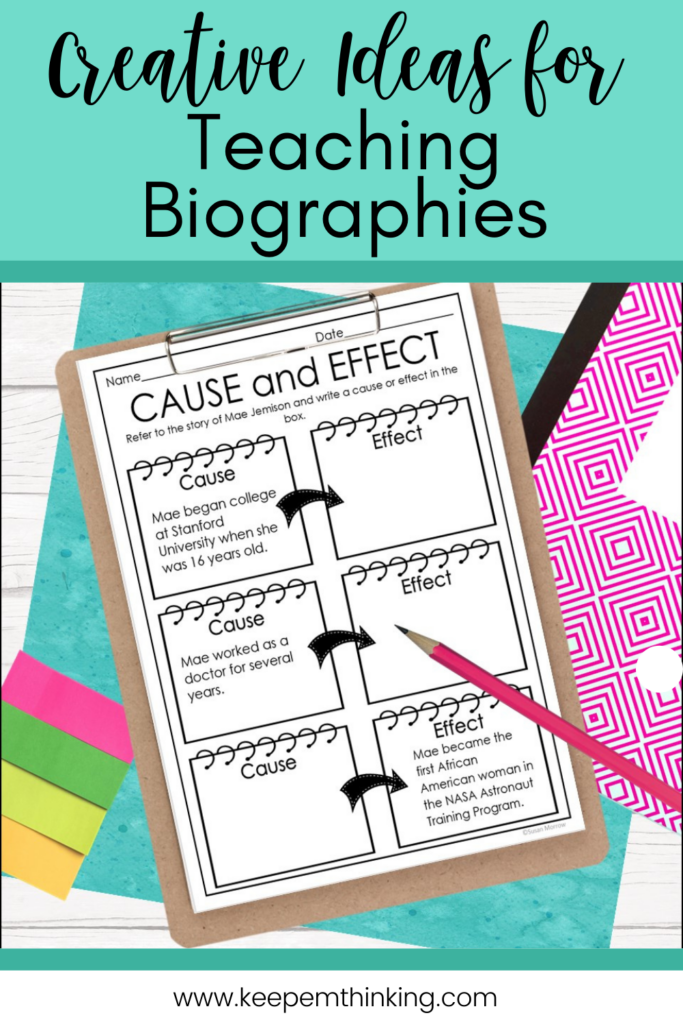
- Read more about: Critical Thinking , Picture Books , Reading and ELA , Thinking Skills , Writing
You might also like...

4 Engaging Reading Interventions All Your Students Will Love
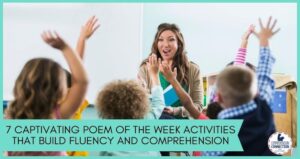
7 Captivating Poem of the Week Activities that Build Fluency and Comprehension
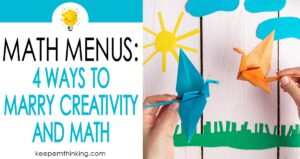
Math Menus: 4 Powerful Ways to Marry Creativity and Math

Search the Blog
Browse by category.
You are using an outdated browser. Please upgrade your browser to use this site.
- Back to Shop By Grade
- Sets by Grade Level
- Spanish Sets by Grade Level
- Preschool Books
- Kindergarten Books
- 1st Grade Books
- 2nd Grade Books
- 3rd Grade Books
- 4th Grade Books
- 5th Grade Books
- 6th Grade Books
- Preschool Spanish Books
- Spanish Kindergarten Books
- 1st Grade Spanish Books
- 2nd Grade Spanish Books
- Back to Shop By Category
- Classroom Library Books
- Book Sets by Reading Level
- Mrs. Wishy-Washy
- Informational Texts
- Narrative Texts
- Chapter Books
- Biographies
- Striving Readers
- Character Sets
- Joy Cowley Books
- Phonics Resources
- Oral Language
- Fiction/Nonfiction Text Sets
- Dual Language Books
- Spanish Big Books
- Professional Development
- Bear & Bobcat
- Back to Shop By Series
- Download Series
- The Extraordinary Files
- Fables & the Real World
- Hameray Biography Series
- Joy Cowley Classics NEW
- Joy Cowley Collection
- Joy Cowley Early Birds
- Kaleidoscope Collection
- Kid Lit NEW
- Letter Buddies
- Oral Language Development Series
- STEM Explorations
- Story World Real World
- SuperScripts
- Underwater Encounters
- Zoozoo Animal World
- Zoozoo Into the Wild
- Zoozoo Storytellers
- Clásicos de Joy Cowley
- Colección Caleidoscopio
- Colección Joy Cowley
- Colección Mi Mundo
- Fábulas y el Mundo Real
- ¡Inspírate!
- Lecturitas NEW
- Mundo de los Cuentos Mundo Real
- Los Pajaritos de Joy Cowley
- STEM Exploraciones NEW
- Zoozoo En la Selva
- Zoozoo Mundo Animal
- Back to Shop Spanish
- Spanish Classroom Libraries
- Spanish Sets by Reading Level
- Spanish Informational Texts
- Spanish Narrative Texts
- Spanish Reading Level A
- Spanish Reading Level B
- Spanish Reading Level C
- Spanish Reading Level D
- Spanish Reading Level E
- Spanish Reading Level F
- Spanish Reading Level G
- Spanish Reading Level H
- Spanish Reading Level I
- Spanish Reading Level J
- Spanish Reading Level K
- Spanish Reading Level L
- Spanish Reading Level M
- Spanish Reading Level N
- Spanish Reading Level O
- Spanish Reading Level P
- Spanish Fiction/Nonfiction Text Sets
- All Spanish Leveled Books
- Back to Shop By Level
- Wordless Books
- Reading Level A
- Reading Level B
- Reading Level C
- Reading Level D
- Reading Level E
- Reading Level F
- Reading Level G
- Reading Level H
- Reading Level I
- Reading Level J
- Reading Level K
- Reading Level L
- Reading Level M
- Reading Level N
- Reading Level O
- Reading Level P
- Reading Level Q
- Reading Level R
- Reading Level S
- Reading Level T
- Reading Level U
- Reading Level V
- Reading Level W
- Reading Level X
- Reading Level Y
- Back to Shop By Content Area
- Social Studies (All)
- All About Me
- Science and Technology (All)
- Earth & Space
- Seasons & Weather
- Technology, Tools, and Math
- Social-Emotional Learning (All)
- Confidence & Feelings
- Helping Others & Our Earth
- Responsibility
- Teamwork & Overcoming Challenges
- Values & Being Your Best Self
- Hobbies & Pastimes
- Holidays & Celebrations
- Plants & Gardens
- Transportation
- Shop Phonics
- Shop Mrs. Wishy-Washy
- Teacher Resources
- Get a Quote
Hameray Classroom Literacy Blog
Using graphic organizers with biographies—with free download.
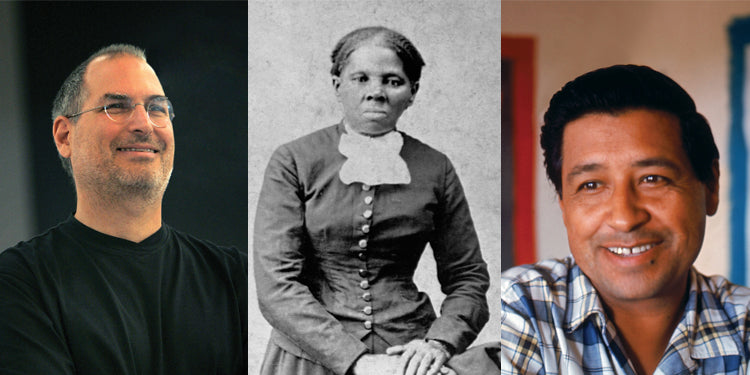
Hello all. I’m Rich from Mr. Giso's Room to Read , and this is my third guest blog post featuring the biographies. You can read the earlier ones here and here . The Hameray Biography Series has been a hit in my multi-age classroom.
Warm weather is (hopefully) upon us! This means many of us may be wrapping up a productive school year or adventuring on an extended year or summer program launch. A goal for my readers over the summer months is that they keep on reading in order to avoid the well-known “summer slide” in reading ability. Our young readers’ reading muscles often weaken from not being kept in shape over the summer.

What I like about these prompts is that they place the readers in the shoes of the subject of the biography. This response activity can be placed in an independent center, sent home in a summer reading log, completed during independent reading just before a reading conference or as a send-off response to text after a guided-reading lesson. It is very versatile! You can download the sheet at the bottom of this page!
Now I've moved to the Carlton Innovation School, also in Salem, Massachusetts, where I am ready to begin my first year as a member of a team of four teachers that teach grades one and two. In addition, I teach undergraduate and graduate students at Salem State University. My courses involve literacy, children's literature, and elementary education. My educational interests include early literacy, effective reading interventions, and positive classroom climates.
For more information about the Hameray Biography Series , click the series highlights image on the left below to download an information sheet with key features. To download the graphic organizer, click the worksheet image to the right.
- Topic: Biographies ,
- Free Activity ,
Related Posts

Four Steps to Improve Your Classroom Library

4 Hands-On Ways to Retell Stories

Teach Foundational Writing Skills with Dictated Sentences

3 Summer Reading Activities to Download Now!

Tips for Teaching with Thematic Text Sets

Activities to Build Character Connections with K–1 Readers

Celebrate the 100th Day with Word Recognition & Fluency A...

8 Ways to Motivate Reluctant Readers

Easy-to-Use Vocabulary Activities For K–5 Classrooms

TABE Conference Raffle Winner

Weekly Literacy Routines with Big Books

Apply Word Work to Simple Text

Hands-On Practice for Tracking Print

Independent Reading Activities to Engage Beginning Readers

Effective Literacy Scaffolds for Language Learners

Practice Vowel Patterns with Word Families

2023 Wishy-Washy Contest Winner

Strengthen Comprehension with Graphic Organizers

DIY Foldable Book: A Comprehension Tool

How to Catch a Gingerbread Man—with FREE Download!

Kick-Start Comprehension: Activities for Beginning Readers

Vocabulary Boards: Versatile Ways to Explore New Words

Creating a Wall Story with Shared Reading

Phonological Awareness with Upper Elementary Students

Compare & Contrast: Activities to Boost Comprehension

Adapting Small-Group Spanish Literacy Instruction, Part 1

Adapting Small-Group Spanish Literacy Instruction, Part 2

Adapting Small-Group Spanish Literacy Instruction, Part 3

Improve Fluency & Oral Language Skills with Reading Buddies

Reinforce Phonics in Small Group Instruction

Nonfiction Texts: An Effective Tool for SEL Discussions

Building Knowledge of Letters, Sounds, Sight Words, and V...
Selecting nonfiction with diversity in mind.

12 Essential Questions to Help Expand Classroom Libraries

6 Tips for Classroom Library Organization

Five Simple Ways to Link Books to Summer Fun

Increasing Language Comprehension with Supportive Book In...

Ideas for Inspiring Reluctant Writers in DLL

2022 Giveaway Announcement

Read-Alouds Facilitate Social-Emotional Learning

Statement | Standing in Solidarity with the AAPI Community

From Phonics to Fluency in Grades K–1

Celebrating Black History Month!

See What's New in 2021!

3 Strategies for Teaching Students to be Active Listeners

Inauguration Day: Compare and Contrast
![graphic organizer for biography 6 Fun and Easy Activities to Practice Sequencing [Grades K-1]](https://www.hameraypublishing.com/cdn/shop/articles/Red_Typographic_Announcement_Twitter_Post-5_bf1ae163-a998-4503-aa03-555b038d1b76_600x.png?v=1689961568)
6 Fun and Easy Activities to Practice Sequencing [Grades...
![graphic organizer for biography Leveraging Prior Knowledge Before Writing and Reading Practice [Grades 1–2]](https://www.hameraypublishing.com/cdn/shop/articles/Red_Typographic_Announcement_Twitter_Post-4_600x.png?v=1689961965)
Leveraging Prior Knowledge Before Writing and Reading Pra...
Kindergarten reading activities for social studies and sc....

Leveled Readers for Kids: Selection Tips for Guided Reading

Biography Graphic Organizers

Download our set of free biography graphic organizers to help organize your student’s research of famous people.
These biography graphic organizers will provide your children with a range of options.
Help your writers and readers as they work to develop research skills.
This is another free resource for teachers and homeschool families from The Curriculum Corner.
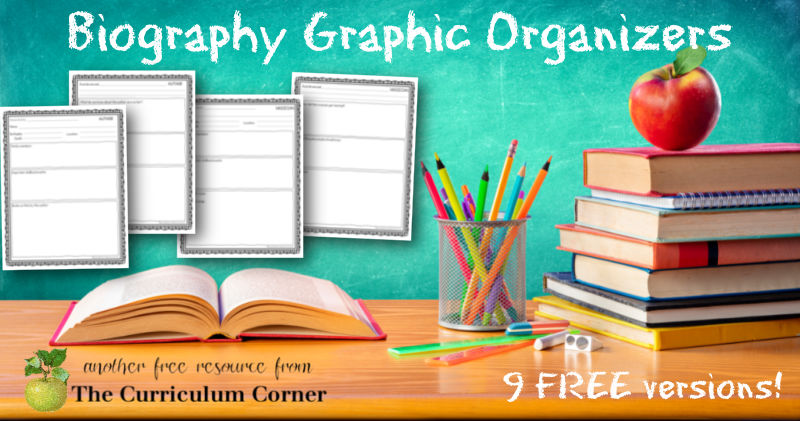
An addition to your classroom research practice!
These famous people graphic organizers are designed to help your students develop their research skills.
Helping students learn how to research and record answers is a skill that can be difficult. It is also a very important skill for students to have in today’s world.
Whether they are researching through reading books or practicing their internet research skills, we hope these printable pages are helpful.
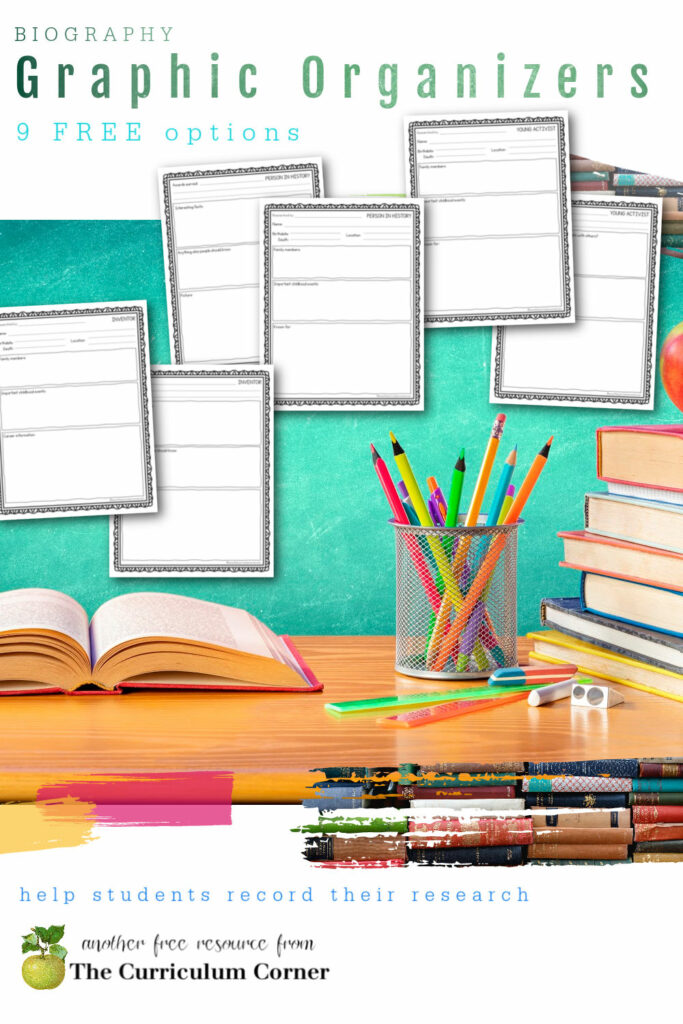
Why did we create these biography graphic organizers?
It can be overwhelming for students to narrow down search results when they complete an internet search.
Part of our job is to help them find accurate and meaningful information when they practice searching.
We feel that providing students with practice with the skill of researching is meaningful practice.
We have created a collection of graphic organizers to help your students record as they are learning about famous people.
For students who might be overwhelmed by searching for the answers, it might be a good idea to help them as they begin.
You can guide students who need a little more help to a specific site where they can find the needed information.
Other students might be able to research on their own without the guidance.
Some children might benefit from a small group where you complete the research together.
Remember to differentiate for your students so that each has a task that fits their needs.
Each of the 8 organizers has a different focus, but is presented in the same format. These will give students a foundation for their knowledge of the person they are learning about.
Plus, we are providing a blank form that can be used for a focus of your student’s choice.
Graphic Organizers Provided
For each topic, we have created a two page graphic organizer for students to record the important facts they find.
For the picture spot, you might have students draw a picture or print one they find when researching.
It might simply be a starting point, or could be an outline from which the students write a biography.
These pages include the following topics:
- actor, actress
- person in history
- trailblazer
- young activist
- any famous person
You can download this free set of graphic organizers here:
Research Download
As with all of our resources, The Curriculum Corner creates these for free classroom use. Our products may not be sold. You may print and copy for your personal classroom use. These are also great for home school families!
You may not modify and resell in any form. Please let us know if you have any questions.
No products in the cart.

FREE Biography Graphic Organizer for Writing
- Description
- View on TpT
Help organise your thinking with this valuable and FREE Biography Graphic Organizer.
Graphic organizers help students write compelling biographies and make teaching easier. They provide a structured way to organize information and foster critical thinking. These tools make complex concepts more accessible and serve as effective assessment instruments. Graphic organizers enhance the biography writing process, empowering students and providing insights for teachers.
It comes in a printable PDF Format and is easy to use.
Download our complete collection of digital and print-based graphic organizers here.
This section explains the specific details of the resource. Please read it to ensure it will meet your needs, and as always, don’t hesitate to email us if you have any specific questions.
Grade Levels:
Grade 1 & 2 / 3rd Grade / 4th Grade / 5th Grade / 6th Grade / 7th Grade / 8th Grade / 9th Grade / 10th Grade / Senior Highschool / Suitable for Homeschooling / Not Grade Specific
Subject Areas:
Critical & Creative Thinking / English (ELA) / Mathematics / Reading / STEM & Digital Technologies / Writing
File Types:
This resource downloads as a XXX File and can be used as a…
Is this Resource Editable?
Yes, elements of this resource are editable, and you can customize it to meet your students’ needs.
Other Important Information for Teachers and Students:
We have been on Teachers Pay Teachers (TpT) for almost a decade now, and fully understand that many of our customers prefer the convenience of buying all their resources from a single online store, as such you can purchase this resource on TpT also.
CLICK TO VIEW THIS RESOURCE ON TPT
If you wish to browse our entire store on TpT click here.

Related products

Digital Graphic Organizers & Thinking Tools for All Curriculum Areas | Editable

FREE Blooms Taxonomy Spelling Activities Matrix | 42 Homework Tasks, Any Words

Fact and Opinion Teaching Unit | Perspective & Bias | Task Cards | Digital & Print

Sentence Structure Unit | Complex Sentences | Compound | Simple | Fragments Etc.

Biography Research: Graphic Organizer Free Printable
for Spark Rewards members.
Easy & FREE to join. Join Now!
Description
Want to add an engaging biography project to your lesson plan? Using the biography research graphic organizer, students can do research on any historical figure of their choosing. Featuring a section for quotes, character traits, and more, children are guaranteed to have fun while researching their figure.
| UPC | |
| Subjects | Social Studies |
Free Resources
Common Core Biography Research Online Graphic Organizer
Students: Use this easy online graphic organizer to guide your research about a chosen person. Customize your title size and font style and then choose a border style for your page. Enter your information into the organizer's form areas. Copy and paste a picture or draw a picture of your person in the picture frame box. When you are done, click the "Generate It!" button to print your page. DONE!

Research Graphic Organizers Online Graphic Organizer Generators
Use these easy and fun online research graphic organizers to guide research about a chosen subject. Customizable with a variety of background choices and font styles. Print finished research or save as .pdf to go paperless!
Graphics Credits:

Back to School Fun, Online No Prep Activities
Get to know your students with these ready to go no-prep online activities. Students will love these fun and customizable "getting to know each other" activities.


What is Graphic Organizer & Types of Graphic Organizers for Teachers and Students
Graphic organizers integrate both text and visuals. This has been scientifically proven to be an effective way of teaching and learning. Using them can be extremely useful for both teachers and students as they will make lessons more engaging as well as easily comprehensible.
We have listed below multiple types of graphic organizers you can use during various scenarios, whether you are reading, writing, doing research or studying for exams. Each tool is accompanied by a template that you can use right away.
What is a Graphic Organizer?
A graphic organizer is a powerful teaching and learning tool designed to organize information and ideas visually, making them easier to comprehend and internalize. By integrating text and visuals, graphic organizers illustrate relationships and connections between concepts, terms, and facts, providing a clear and structured way to present complex information. This visual representation aids in simplifying intricate ideas, enhancing understanding and retention for learners of all ages and abilities.
Graphic organizers can be used across all grade levels, serving as effective learning tools for both gifted children and students with special needs. For gifted students, these tools offer a way to explore complex concepts more deeply and independently, encouraging advanced thinking and creativity. For students with special needs, graphic organizers break down information into smaller, more manageable parts, facilitating comprehension and aiding in the retention of new material. By catering to diverse learning styles, graphic organizers provide an inclusive approach to education that can be tailored to meet individual needs.
In the context of adult learners, graphic organizers play a crucial role in bridging the gap between existing knowledge and new information. Adults often enter the learning environment with a rich background of experiences and prior understanding. Graphic organizers help them connect this existing knowledge with newly acquired concepts, fostering a deeper and more integrated learning experience. By visually mapping out information, adult learners can better organize their thoughts, identify areas that require further exploration, and develop a more comprehensive understanding of the subject matter.
Benefits of graphic organizers
Graphic organizers are valuable tools for several reasons. They offer numerous benefits that enhance learning and teaching experiences for students and educators alike. Here are some key reasons why you need to use graphic organizers.
1. Simplify complex information
Graphic organizers provide visual clarity by presenting complex information in a way that is easy to understand and process. They break down intricate ideas into smaller, more manageable parts, allowing students to see the relationships between concepts clearly and facilitating comprehension of the big picture.
2. Improve comprehension and retention
The combination of text and visuals in graphic organizers improves memory retention by offering visual cues that reinforce learning. They help students connect new information to prior knowledge, fostering deeper understanding and aiding long-term retention of material.
3. Support diverse learning styles
Graphic organizers cater to different learning styles, including visual, auditory, and kinesthetic learners, by providing a structured format that can be customized to meet diverse needs. They are particularly beneficial for students with special needs, offering an inclusive approach that accommodates various learning challenges.
4. Encourage critical thinking and problem solving
By encouraging students to analyze and evaluate relationships between ideas, graphic organizers foster critical thinking and problem-solving skills. They help learners organize their thoughts systematically, enabling them to approach problems strategically and develop effective solutions.
5. Facilitate active learning and engagement
Graphic organizers actively engage students in the learning process, making lessons more interactive and enjoyable. They promote collaborative learning by allowing students to work together to fill in or create organizers, encouraging teamwork and communication in the classroom.
6. Versatile and adaptable
Graphic organizers can be adapted for use in any subject or discipline, making them versatile tools in education. They come in various formats, such as mind maps, Venn diagrams, and flowcharts, providing flexibility to suit different educational needs and learning objectives.
7. Improve instruction and assessment
Teachers can use graphic organizers to present information clearly and assess student understanding efficiently. They serve as valuable tools for formative assessment, allowing educators to gauge student comprehension and identify areas that need further attention, ultimately improving educational outcomes.
Types of Graphic Organizers
Here we have listed 20 types of graphic organizers for teaching and learning. Based on their varied purposes, you can utilize them in reading, writing, researching, brainstorming, and analyzing.
Graphic Organizers for Compare and Contrast
Graphic organizers for comparing and contrasting are a type of graphic organizer that help students visually map out similarities and differences between two or more items, concepts, or ideas. These compare and contrast graphic organizers are designed to clarify and simplify the process of comparison by providing a structured format that highlights the key attributes of each item being examined.
1. Double bubble map
The double bubble map is one of the popular thinking maps and used as a type of graphic organizer. It is much like a Venn diagram and is used to identify similar and different qualities between two things. Students can use bubble map maker to create double bubble map.
How to use it?
Step 1: Write down the two ideas/ topics you are comparing in the two bubbles in the center.
Step 2: As you brainstorm and analyze the topic, write down the differences in the bubbles radiating from the center.
Step 3: Write down the similarities in the bubbles that are common to both topics.

2. Venn diagram
Another graphic organizer that helps you visually represent a comparison of differences and similarities between two subjects, is the Venn diagram. What makes it different from the is that it can include more than two topics and one common area. Using differnt venn diagram templates , student can represent comparions visually.
How to use it
It works similar to the double bubble map.
Step 1: Write down the topics being compared on the top of each circle.
Step 2: Writ down the differences or unique characteristics inside its own sector avoiding the overlapping area.
Step 3: List the similarities in the common area.
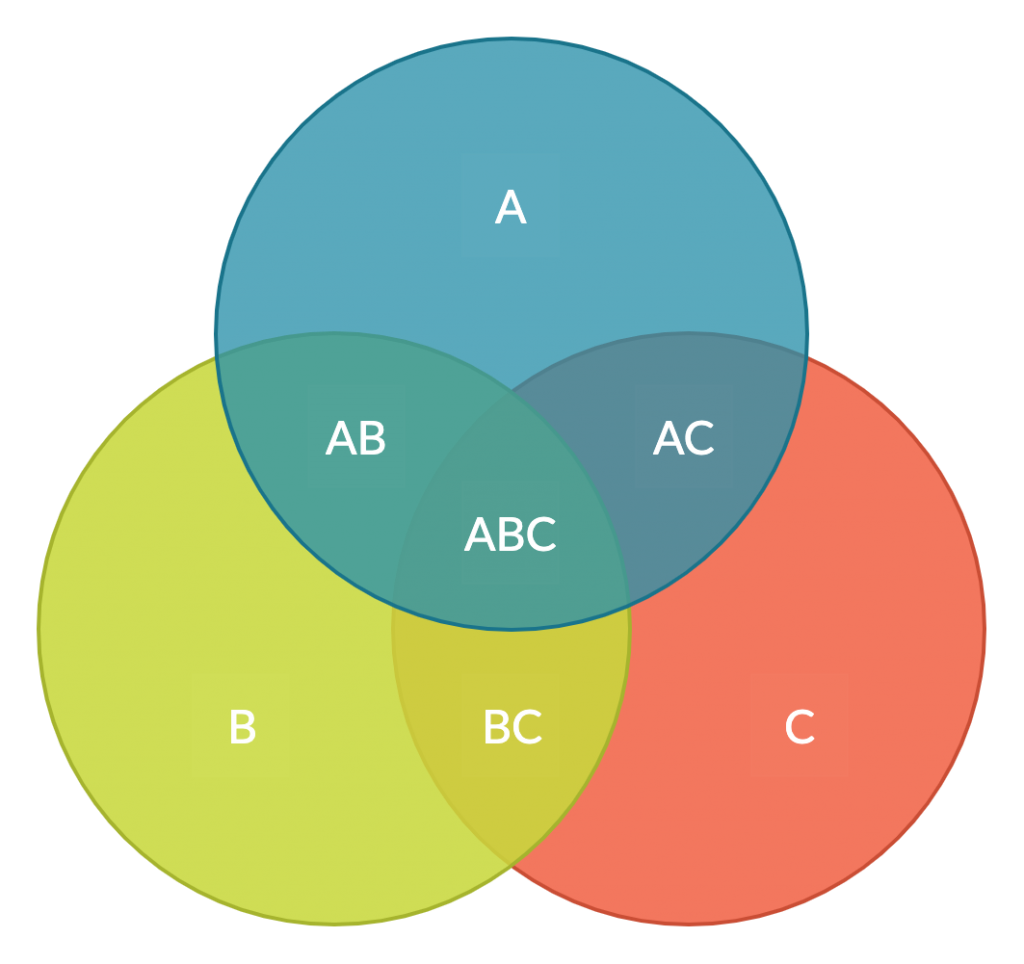
Graphic Organizers for Writing
Graphic organizers for writing are a type of graphic organizer that help students plan and organize their ideas before they start writing. These writing graphic organizers provide a visual structure for organizing thoughts, which makes the writing process clearer and more manageable.
3. Persuasion map
The persuasion map is an interactive graphic organizer that helps students familiarize themselves with the process of persuasive writing . It assists them with outlining and preparing arguments for their essays, speeches, debates, etc.
Step 1: Choose a topic of interest for your essay/debate. Do proper research around it to collect enough information.
Step 2: Define the claim that you want to make with your essay. Persuasive writing by writing this down first.
Step 3: Next to it, write down the reasons for making that claim.
Step 4: Then write down facts, examples, and information to back up your reasoning.
Step 5: End your persuasion map with the conclusion of your essay.
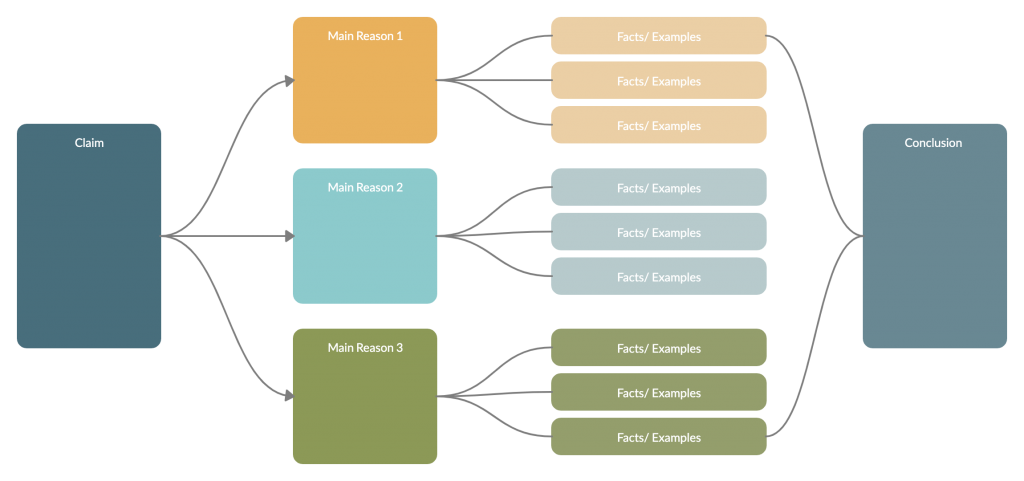
4. Sequence Chart
A sequence graphic organizer is a tool that helps visualize the order of steps of a process or a timeline of events, etc. It can also be used for note-taking, lesson planning, and essay writing.
Step 1: Identify the steps in the process or event.
Step 2: Using a sequence chart arrange these steps in sequential order.
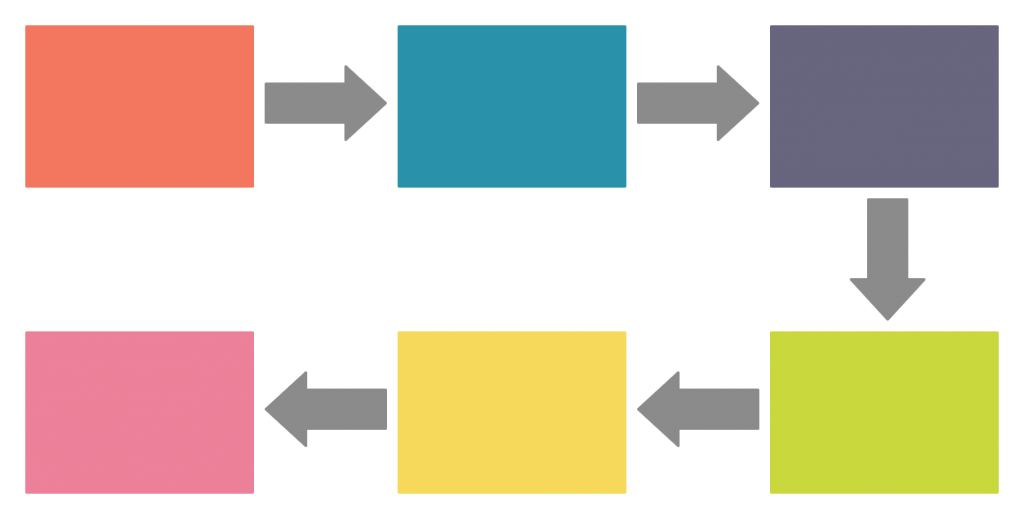
Graphic Organizers for Reading
Graphic organizers for reading are a type of graphic organizers that help students understand and analyze texts more effectively. Reading graphic organizer provides visual ways to organize information from a reading passage, making it easier to grasp key ideas and details. Graphic orgnizer for reading provides visual structures to help students break down information, see relationships, and remember key ideas, ultimately enhancing their reading comprehension.
5. Story map
A story map can be used to identify the different elements such as characters, character plots, themes, techniques, etc. in a book students are reading. It’s a useful graphic organizer that teachers can integrate into the lesson to improve students’ comprehension.Teachers can use Storyboard maker to create appealing story maps.
Step 1: Read the book and understand it well.
Step 2: Discuss the different significant elements that were involved in the story. These could be the characters, setting, problem and solution, etc. You can fill the story map during the discussion.
Step 3: Once the map is complete you can discuss each element individually.
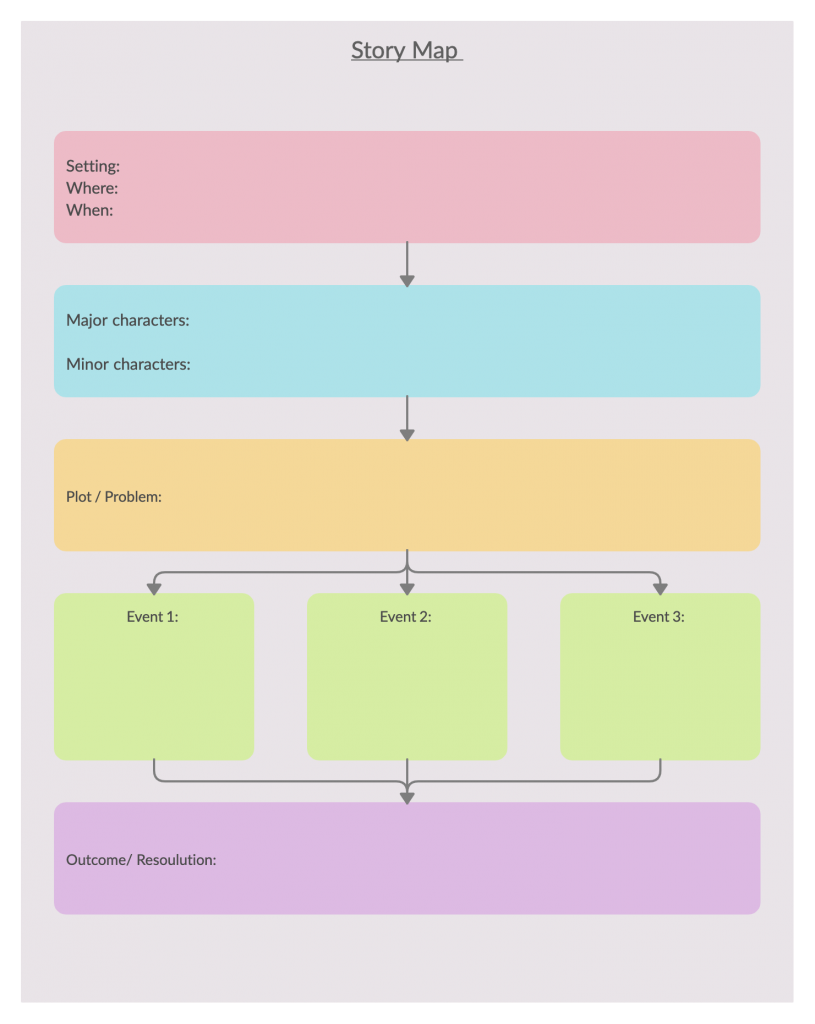
6. Biography graphic organizer
This is a tool that assists with understanding a character from a novel, autobiography or movie or a historical figure more in-depth. It brings attention to various important factors about a person’s life.
How to create it
Step 1: Gather as much information you can about the character you are studying. You can also refer to online resources, or ask from teachers or experts.
Step 2: As you analyze the information you have gathered, isolate the facts that stand out or you think are important.
Step 3: Use your biography graphic organizer to lay out the information in a presentable way. You can add images to make it more comprehensible as well.
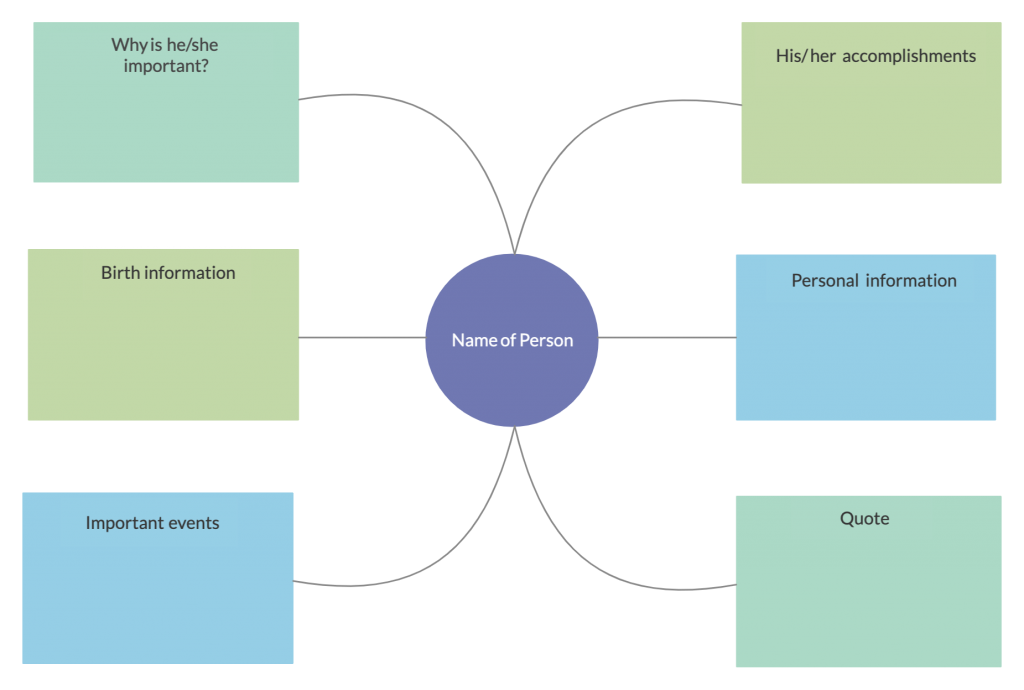
7. KWL chart
KWL chart is used for gathering information from student’s prior knowledge or experience. This 3 column chart captures the before (what the reader already knows), during (what the reader wants to learn) and after (what the reader learned) stages of reading. Using KWL templates , students can easily create KWL charts.
Step 1: Get students to brainstorm around the selected topic and write down everything they know about it in the K column.
Step 2: Ask them to generate a list of questions about what they want to know in the W column of the chart.
Step 3: During or after reading the book/ lesson get them to answer these questions in the L column.

Graphic Organizers for Teaching
Graphic organizers for teaching are a type of graphic organizers that help educators plan and present lessons more effectively. Teaching graphic organizer provides a structured way to organize information, making it easier for teachers to convey concepts clearly and for students to understand and engage with the material.
8. Learning map
Learning maps visually depict the key takeaways – skills, ideas, knowledge – students should get from a lesson. It usually provides a high-level view of the lesson/ unit/ course that is to be studied and the connection between its different components. Students can also use learning map template in the classroom for note-taking.
Step 1: At the center of the map, write down the topic (i.e. name of the lesson or unit)
Step 2: Brainstorm ideas and information related to it. Write these down on branches emerging from the center. Make sure that you place them in a way that makes sense to teach or in a logical sequence around the center.
Step 3: Add connectors between these elements and add labels to highlight the kind of relationship between them.

9. Analogy graphic organizer
The analogy graphic organizer uses analogy to help students identify similarities and differences between a new topic and a topic that they are already familiar with.
Step 1: Select a topic/ concept that the students already know and is analogous in certain aspects to the new topic
Step 2: Introduce the new concept and get the students to read and discuss it
Step 3: Using an analogy graphic organizer, ask the students to brainstorm and write similarities and differences between the two topics.
Step 4: Based on the completed graphic organizer, ask the students to write a brief description of the new topic

Analogy Graphic Organizer (Click on the template to edit it online)
10. Vocabulary graphic organizer
This tool can be used to assess the vocabulary knowledge of students. You can create graphic organizers including various elements to help students learn new words, and learn antonyms and synonyms.
Step 1: Write the new vocabulary word at the top of the template. This is the focus of your study
Step 2: Ask students to write down the definition of the Vocabulary in the Definition box
Step 3: List synonyms (words with similar meanings) of the word. This helps you see the word in relation to others
Step 4: Group the students and ask them to use the vocabulary in new sentences
Step 5: Ask students to draw or find an image or symbol that represents the word
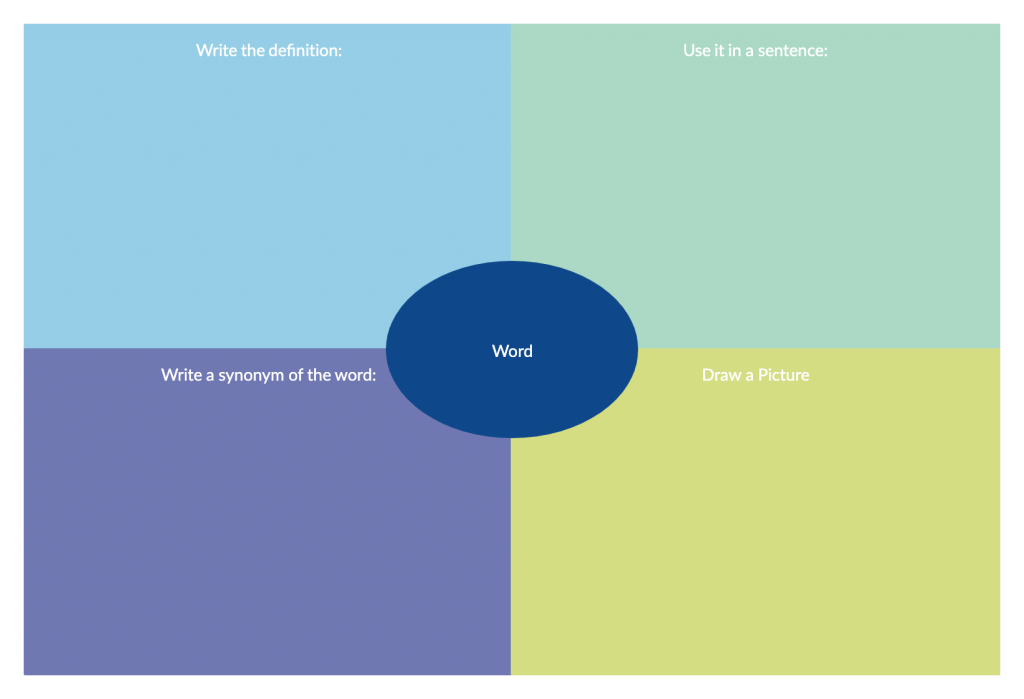
11. Problem-solving organizer
Problem-solving graphic organizers can be used to improve the problem-solving skills of the students. It helps students identify and evaluate solutions to problems.
Step 1: Identify the problem and write it in the problem box
Step 2: Ask students to then write down why they think it is a problem in the first place
Step 3: Get them to brainstorm all possible solutions along with the pros and cons relates to them.
Step 4: Once they select the best possible solution, ask them to list down all its possible consequences
Step 5: Students can then make suggestions to improve the selected solution further

12. Math Graphic Organizer
Math graphic organizers are used to describe math concepts graphically to students. It helps with simplifying and solving complex math problems.
Step 1: Select the math problem you want to identify and a relevant math graphic organizer that you can use to solve it.
Step 2: Invite your students or colleagues to collaborate as you wish.
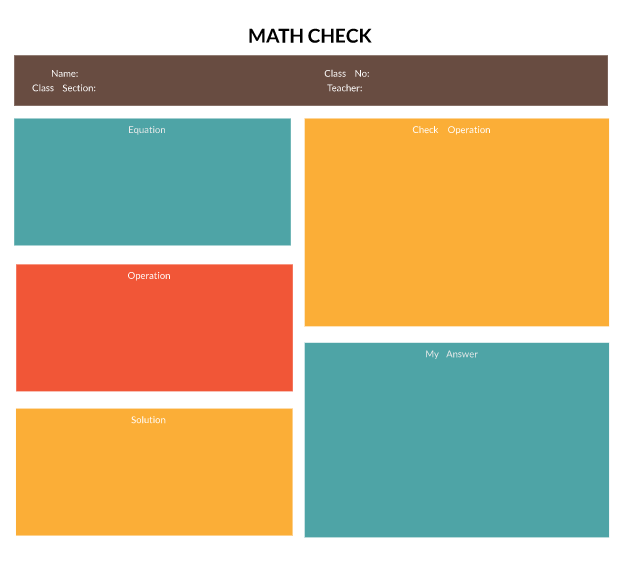
Graphic Organizers for Learning
Graphic organizers for learning are a type of graphic organizers that help students understand, organize, and remember information more effectively. Learning graphic organizer helps break down complex material into manageable parts, illustrate relationships between ideas, and enhance memory retention. By using these tools, students can improve their comprehension, organize their thoughts, and engage more effectively with their learning material.
13. Timeline graphic organizer
Timeline diagrams are a type of graphic organizer that shows a sequence of events in chronological order.
They come in handy when studying history as you can use it to display major historical events that occurred during a period of time along with important details such as dates and locations in which they took place. Timeline maker helps to create historical event timleine graphic organizer easily.
In addition, timeline charts can also be used to show the progress of something (i.e. growth of a business) or changes.
Step 1: Identify the different events and the sequence of order in which they took place.
Step 2: Use a research on your target audience to arrange them chronologically
Step 3: Include significant details such as dates, locations and other additional information as needed.

14. T chart
T charts allow students to study two facets of a topic. For example, disadvantages and advantages, pros and cons, differences and similarities, etc.
Step 1: Draw a T chart using a T chart maker and write down the two areas you want to brainstorm around on each column head.
Step 2: Write down facts on each column as you carry out your brainstorming.
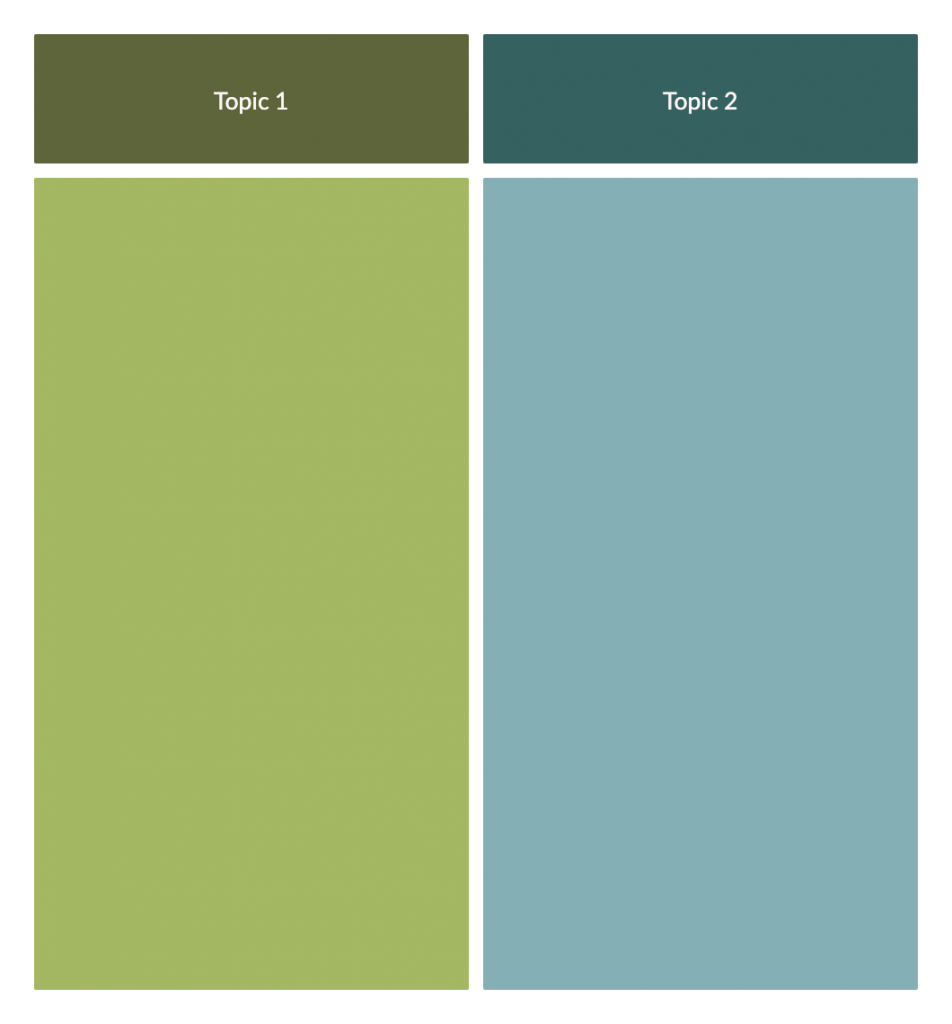
15. Hierarchy chart graphic organizer
Hierarchy charts visualize the elements of a system, organization or concept from its highest position to the lowest. Students can use this tool to understand the superordinate and subordinate categories of a topic and the relationship between them.
Step 1: Identify the most important element under the topic you are studying. Write this down at the top of the hierarchy chart.
Step 2: List down the second layer of sub-elements stemming from the first component you have identified. Add a third and fourth as necessary.
Step 3: Connect these with lines to show how they are connected to each other.

16. Star diagram graphic organizer
Star diagrams are used to organize the characteristics of a chosen topic. It can also be used to brainstorm around new topics.
Step 1: Select the topic you want to study and write it down in the center of the star diagram template .
Step 2: Write down the characteristics or attributes related to the central topics on each point of the star. Adjust the points of the star depending on how many traits you write down.
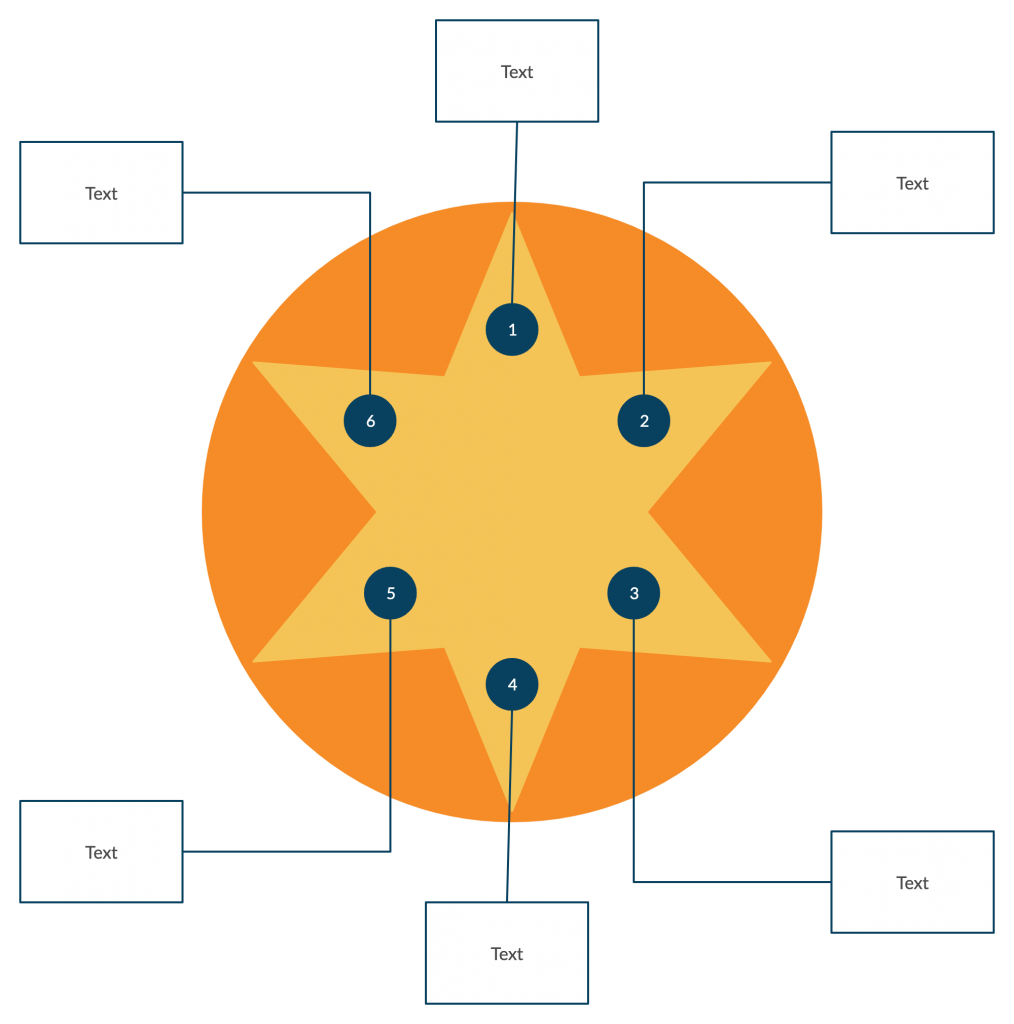
Graphic Organizers for Brainstorming
Graphic organizers for brainstorming are a type of graphic organizers that help students and teams generate, organize, and explore ideas. They help individuals and teams generate and organize ideas more effectively. Brainstorming graphic organizers provide a clear visual structure for exploring various aspects of a topic, making it easier to capture and evaluate creative thoughts. By using these tools, users can improve creativity, streamline idea generation, and better organize their brainstorming sessions.
17. Cluster diagram
Cluster diagrams can be used to facilitate a brainstorming session or structure idea generation and even to help with exploring new topics.
Step 1: Pick your topic of interest to explore. This should be placed in the middle of the diagram.
Step 2: Brainstorm around this main idea and come up with sub-topics related to it. Place them around the center.
Step 3: Brainstorm around each of the sub-topics and write down related ideas around them.
Step 4: Add as many layers as you want. However, use color-coding to emphasize each branch of thought. This will make it easier for you to read and understand the cluster diagram.

18. Lotus diagram
Lotus diagram is an analytical tool that can be used to breakdown broader and more complex topics into smaller components for easy understanding. It can be used for brainstorming and studying new topics.
Step 1: Draw a 3×3 grid in the center. On the square in the center, write down the main topic to be explored.
Step 2: Write down the related sub-topics around it as you brainstorm.
Step 3: Draw 8 more 3×3 grids around the one in the center. Each of these can be used to write down facts that you brainstorm around each subtopic.
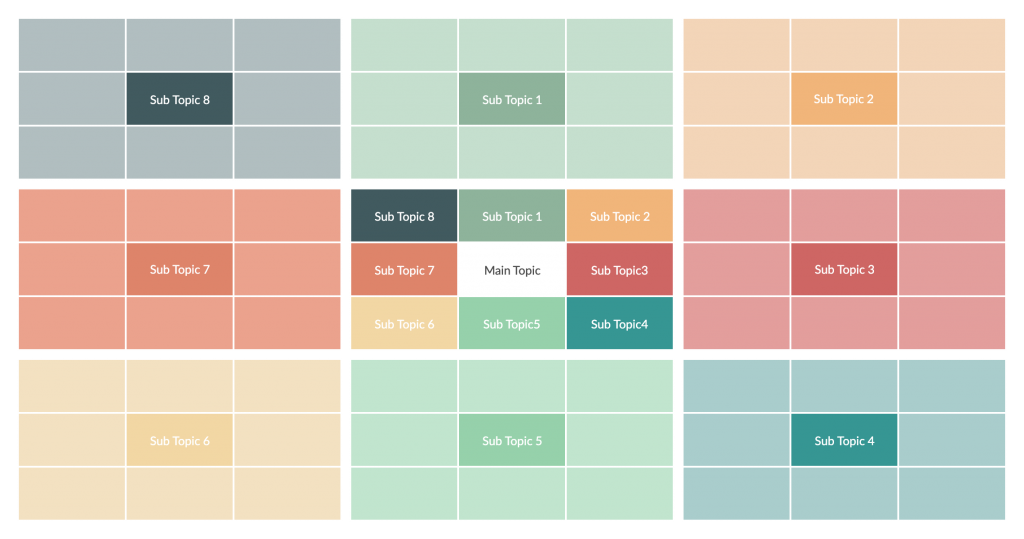
19. Cause and effect graphic organizer
This type of graphic organizer shows the causes and effects of an event. The cause is the reason why something has happened, and effect is the result of what has happened. Visualization helps clearly understand the different cause and effect relationships.
Using a cause and effect graphic organizer, identify the causes and effects related to the problem you are studying or writing about. There could be several models of cause and effect events, such as one cause leading to one effect or multiple effects, or multiple causes leading to one effect or multiple effects.
- One cause leading to several effects
- Several causes leading to one effect (You can use a fishbone diagram templates here)
- Each cause having one related effect
- One cause triggering another cause that leads to another

20. Mind map
A mind map is a tool that helps capture the free flow of thought and is widely used for brainstorming around topics. Additionally, it can also be used to organize and group information about a topic.
Step 1: Write down the topic you are brainstorming around in the center.
Step 2: On branches emerging from the middle, write down brainstormed ideas/ thoughts.
Step 3: Expand each sub idea with more facts. You can keep on adding more information to your mind map until you have enough.

How to Visualize a Graphic Organizer
To visualize a graphic organizer, follow these easy simple steps. You can use Creately to simplify the process of visualizing a graphic organizer.
1. Decide what you need
Start by determining the purpose of your graphic organizer. Are you organizing ideas for a project, comparing concepts, or planning a story? Understanding what you need will guide the design of your organizer. Decide what information or ideas you need to include. This might involve brainstorming or gathering data from your notes or research to ensure you cover all necessary points.
Use Creately’s graphic organizer maker , templates and brainstorming tools to identify and outline your needs. Explore different graphic organizer templates available in Creately to determine which fits your purpose, whether it’s for organizing ideas, comparing concepts, or planning projects.
2. Pick a type
Choose a graphic organizer type that best suits your purpose. For example:
- Mind maps are great for brainstorming and showing connections between ideas.
- Venn diagrams are useful for comparing and contrasting two or more items.
- Flowcharts help illustrate processes or sequences of steps. Think about who will use the graphic organizer. Choose a type that will be easy for them to understand and interact with. Creately offers a wide range of graphic organizer templates, such as mind maps, Venn diagrams, flowcharts, and T-charts. Choose a template that suits your purpose from its collection.
3. Start with the main idea
Begin by placing the main idea or central topic in a prominent position, such as the center of a mind map or the top of a flowchart. This will be the focal point of your organizer. Use Creately’s formatting tools to make the main idea stand out with colors, fonts, or different shapes. This ensures that it is immediately noticeable and serves as the anchor for other information.
4. Add details
Include supporting information: Add related ideas, details, or subtopics around the main idea. For a mind map, these will branch out from the central topic. In a Venn diagram, they will be placed in the appropriate circles.
Use connections: Draw lines or arrows to connect related details. This helps to show how different pieces of information are linked to each other and to the main idea.
Be clear and concise: Use brief phrases or keywords rather than long sentences to keep the organizer easy to read and understand.
5. Organize and arrange
Arrange logically: Position the elements in a logical order. For instance, in a flowchart, arrange steps sequentially. In a mind map, place related ideas close to each other.
Ensure clarity: Make sure the connections between elements are clear and not overlapping. Arrange the elements in a way that avoids clutter and makes the organizer easy to follow.
Use visual aids: Incorporate colors, shapes, or symbols to differentiate between types of information or to highlight important points.
6. Review and adjust
Check for completeness: Review the organizer to ensure that it includes all relevant information and that nothing important is missing.
Simplify if needed: If the organizer looks too crowded or confusing, simplify by removing unnecessary details or reorganizing elements.
Seek feedback: If possible, ask someone else to review the graphic organizer. They can provide insights on clarity and suggest improvements. Creately allows for real-time collaboration and feedback, making it easy to review and adjust your graphic organizer. You can also use version history to track changes.
Limitations of Graphic Organizer
While graphic organizers are valuable for organizing and understanding information, they have limitations. It’s important to use them thoughtfully and consider other methods when needed.
1. Oversimplification
Graphic organizers can sometimes oversimplify complex information. By breaking down ideas into visual formats, they might leave out important details or nuances, which can lead to incomplete understanding.
2. Limited scope
They often focus on specific aspects of information and might not capture the full scope of a topic. This can limit their effectiveness if you need a more comprehensive view or in-depth analysis.
3. Reliance on visuals
Graphic organizers rely heavily on visual representation, which might not suit all learners. Some people may find it challenging to translate visual information into a coherent understanding or prefer different methods of organization.
4. Time-consuming
Creating and filling out graphic organizers can be time-consuming, especially if they are complex. This can be a drawback if time is limited or if a simpler approach would be more efficient.
5. May not fit all subjects
Not all subjects or topics are well-suited for graphic organizers. Some areas of study may require different methods or tools to effectively convey information and facilitate learning.
6. Potential for confusion
If not designed clearly, graphic organizers can become cluttered or confusing, which may hinder rather than help the learning process. It’s important to ensure that the organizer is well-structured and easy to understand.
Add to Our List of Graphic Organizers for Teachers and Students
Although we have covered 20 types of graphic organizers in this post, there are plenty more that can be useful to our users. Know more? Mention in the comments section below to keep expanding the list of ultimate graphic organizers.
FAQs About list of Graphic Organizer
What are the 6 types of graphic organizers.
Graphic organizers are designed to help with various tasks, from comparing and contrasting to planning writing and enhancing learning. Each organizer offers a visual method for structuring and understanding information effectively. Here are the 6 types of graphic organizers;
- Graphic organizers for compare and contrast
- Graphic organizers for writing
- Graphic organizers for reading
- Graphic organizers for teaching
- Graphic organizers for learning
- Graphic organizers for brainstorming
What is the easiest graphic organizer?
What is a 5 w’s graphic organizer, how to select the right graphic organizer for a specific project.
When selecting a graphic organizer for a specific project, you should consider the type of information you need to organize and the purpose of the project. Here are some tips on how to select the right graphic organizer:
Identify the type of information: Before selecting a graphic organizer, consider the type of information you need to organize.
Determine the purpose of the project: Consider the purpose of the project and what you want to achieve.
Consider the audience: Think about who the audience is for the project. If the audience is young children, a simpler graphic organizer like a picture web might be more appropriate. If the audience is adults, a more complex graphic organizer like a timeline or a chart could be suitable.
Evaluate the effectiveness of different graphic organizers: Try out different graphic organizers and see which ones work best for you. Creately has different graphic organizer editable templates that you could use to create your graphic organizer based on the purpose.
Be creative: Don’t be afraid to create your own graphic organizer or adapt an existing one to meet your needs. Graphic organizers are flexible tools that can be customized to fit different projects and purposes.
What are the common mistakes to avoid when creating a graphic organizer?
Avoid these common mistakes that you make to ensure that your organizer is effective in conveying information.
Avoid overcomplicating the design of your graphic organizer: It should be easy to read and understand, therefore avoid using too many colors, fonts, or shapes which make the organizer confusing and difficult to read.
Consistency is important in creating a graphic organizer. Use the same formatting, color scheme, and font throughout the organizer to ensure that it is easy to follow and understand.
The purpose of a graphic organizer is to simplify and organize information. Including too much information can defeat the purpose and make the organizer overwhelming. Stick to the most important information and use the organizer to highlight key concepts and relationships.
Use clear and appropriate labels for each section of the organizer. Avoid using labels that are too vague or unclear, as this can cause confusion and make it difficult to understand the relationships between the different elements.
Consider who the audience is for the graphic organizer and use appropriate language and images. Avoid using jargon or technical terms that may not be familiar to the audience.
Test your graphic organizer to ensure that it effectively conveys the intended information. Ask for feedback from others and make revisions as needed.
What software can be used to create graphic organizers?
Join over thousands of organizations that use Creately to brainstorm, plan, analyze, and execute their projects successfully.
More Related Articles

Amanda Athuraliya is the communication specialist/content writer at Creately, online diagramming and collaboration tool. She is an avid reader, a budding writer and a passionate researcher who loves to write about all kinds of topics.
Teach Starter, part of Tes Teach Starter, part of Tes
Search everything in all resources
Famous Historical Figures - Biography Graphic Organizer Packs
Updated: 28 May 2023
Dive into a research project on key figures in history with a set of Important Historical Figure graphic organizers.
Non-Editable: PDF
Pages: 4 Pages
Grades: 2 - 5
- Founding Fathers (pdf) Sign up to Plus
- Human Rights (pdf) Sign up to Plus
- Texans (pdf) Sign up to Plus
- Scientists (pdf) Sign up to Plus
- Women of History (pdf) Sign up to Plus

Famous Historical Figures – Biography Graphic Organizer Packs!
Research projects in the classroom can be daunting. Assigning individual research topics, fielding two-hundred questions, and managing the progress of each student can be quite the task. We’re all for making lives simpler, especially teachers’ lives. That’s we have developed these historical figures research project templates
Since there are so many amazing Americans in our history , we’ve divided our resources into five different groupings of templates, centered around a common theme. The resource groupings included are
Important Women in History
This grouping includes a biography graphic organizer for Clara Barton, Harriet Tubman, Sacagawea, Susanna Dickinson, Susan B. Anthony, Sojourner Truth, Helen Keller, Ruby Bridges, and Irma Rangel.
Scientists, Inventors, and Astronauts
This grouping includes a biography graphic organizer for Bill Gates, Henry Ford, George Washington Carver, Jonas Salk, Louis Pasteur, James Lovell, Cyrus McCormick, and Neil Armstrong.
Influential Texans
This grouping includes a biography graphic organizer for Davey Crockett, Irma Rangel, William B. Travis, Hector P. Garcia, Todd Beamer, Sam Houston, James Bowie, Juan Seguin, Susanna Dickinson, and Cesar Chavez.
Human Rights Heroes
This grouping includes a biography graphic organizer for Sojourner Truth, Irma Rangel, Helen Keller, Amelia Earhart, Hector P. Garcia, Ruby Bridges, Harriet Tubman, Cesar Chavez, Thurgood Marshall, Frederick Douglass, and Susan B. Anthony.
America’s Founding Fathers
This grouping includes a biography graphic organizer for Benjamin Franklin, Thomas Jefferson, Abraham Lincoln, and George Washington.
Download & Print — It’s Child’s Play!
Use the dropdown arrow on the Download button to select the grouping of research templates of your choice. Download the PDF file, make your copies, and you are ready to go! Simple, effective, and organized for your convenience.
While you’re here, check out more activities and teaching resources that fill your lesson plans and students’ brains:
| [resource:4804502] [resource:4793782] [resource:4820963] |
Teach Starter Publishing
We create premium quality, downloadable teaching resources for primary/elementary school teachers that make classrooms buzz!
Write a review to help other teachers and parents like yourself. If you'd like to request a change to this resource, or report an error, select the corresponding tab above.
Suggest a Change
Would you like something changed or customised on this resource? While our team makes every effort to complete change suggestions, we can't guarantee that every change will be completed.
Report an Error
Did you spot an error on this resource? Please let us know and we will fix it shortly.
Are you having trouble downloading or viewing this resource? Please try the following steps:
- Check that you are logged in to your account
- For premium resources, check that you have a paid subscription
- Check that you have installed Adobe Reader ( download here )
If you are still having difficulty, please visit the Teach Starter Help Desk or contact us .
You may also like
- English Language Arts →
- Types of Writing →
- Expository Writing →
- Social Studies →
- Women's History Month 2024 →
- Templates →
- Historical Figures →
- Writing Templates →
- 2nd Grade →
- 3rd Grade →
- 4th Grade →
- 5th Grade →
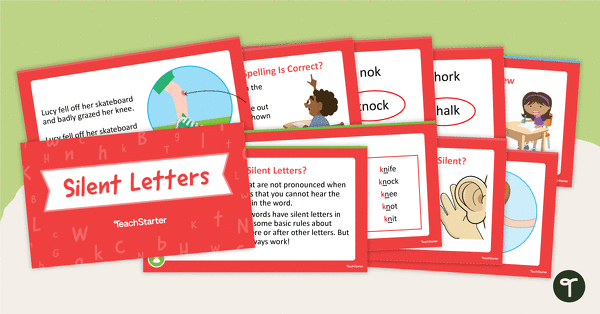
Silent Letters PowerPoint
A 24-slide editable PowerPoint presentation about silent letters.
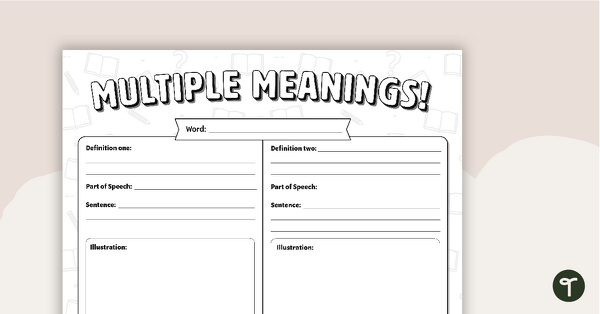
Multiple Meanings Vocabulary Worksheet
A worksheet to use in the classroom when identifying multiple-meaning words.

Bloom's Taxonomy Fast Finisher Task Cards - Upper Grades
44 Bloom's Taxonomy fast finisher activity cards.
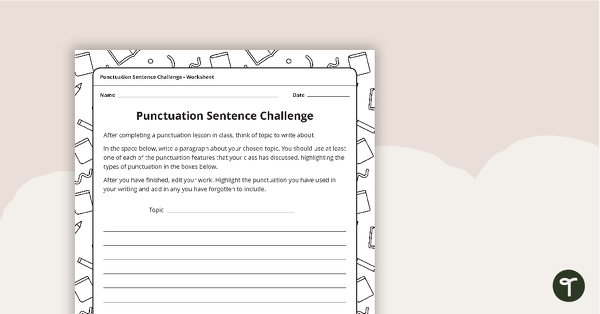
Punctuation Sentence Challenge Worksheet
A teaching resource to help consolidate the students’ knowledge of punctuation.
Common Core State Standards Progression Trackers - Kindergarten - Language
Individual student and whole class trackers using the Language Common Core Standards.
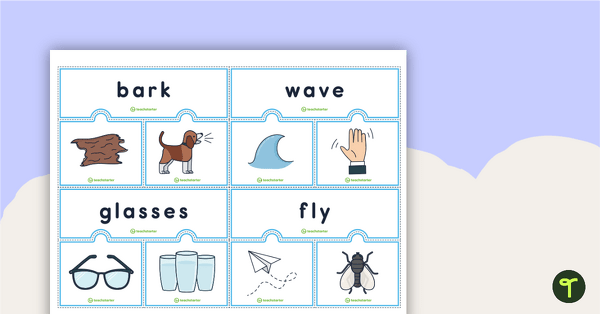
Multiple-Meaning Word Puzzles
16 puzzles to use in the classroom when identifying homonyms.
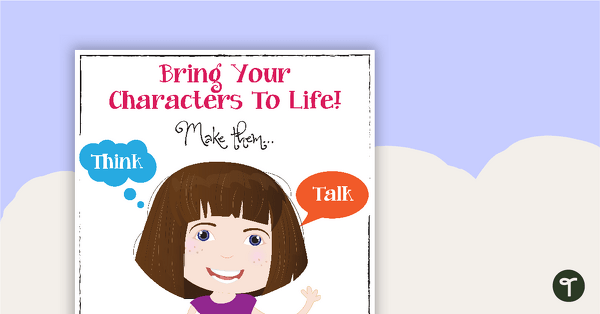
Bring Your Characters To Life Poster
A poster to remind your students to add detail and description to their writing to bring their characters to life.
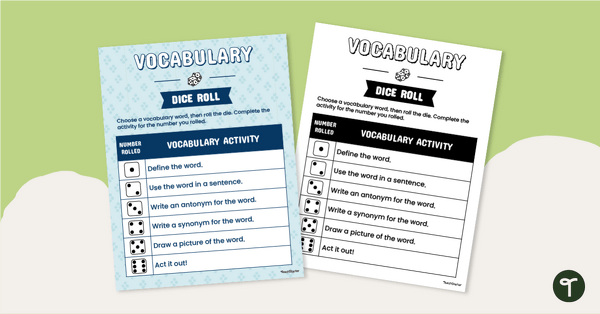
Vocabulary Dice Roll Activity
6 vocabulary activities to use with a range of words.

Verb Past Tense Worksheet
A worksheet with simple and irregular past tense verbs added to complete the sentences.
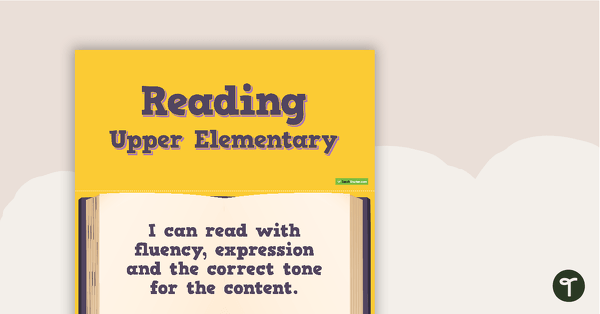
'I Can' Statements - Reading (Upper Elementary)
A set of 26 'I can' statement cards focusing on reading for upper elementary.
Graphic Organizer: Biography Research
Help plan and research a biography with this helpful graphic organizer! Prompts guide children as they learn about the subject of their biography, with thoughtful questions to help students consider the influences and events that shaped this person's life and work. Designed for third and fourth graders, this versatile graphic organizer can be used on its own, or as a research and pre-writing tool.
View aligned standards
Related guided lesson.

Letter Writing 1

Biography Graphic Organizer PDF
Biography Graphic Organizer - Elementary
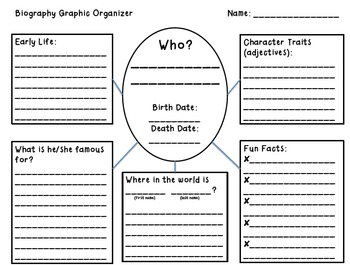
Description
Questions & answers, jennifer caine.
- We're hiring
- Help & FAQ
- Privacy policy
- Student privacy
- Terms of service
- Tell us what you think

COMMENTS
Learn how to create a biography graphic organizer with various templates and examples. A biography graphic organizer is a tool to visually represent a person's life from a third-person perspective.
Find a collection of graphic organizers to help fourth and fifth grade students explore biographies during reading workshop. Learn how to use these tools to teach the difference between narrative and expository nonfiction, character traits, influences, notes, reflections, questions, cause and effect, and life lessons.
This biography graphic organizer consists of an oval (with the person's name) surrounded by data rectangles. It prompts the student to list the person, the birth (date and place), family, early life, education, adult life, major accomplishments, how the accomplishments changed the world, and death (date and place). Biography Pyramid Printout.
Enhance Biography Writing with a Biography Graphic Organizer. A graphic organizer is a valuable tool that can greatly enhance the process of writing biographies. It provides a structured format for organizing information and helps students gather and present key details about a person's life in a clear and logical manner.
Create a workspace on Creately and use one of the existing biography graphic organizer templates or start from scratch. Include all the above information categorically. Add the supporting information, facts or details under each category and fill out the biography graphic organizer. Share your biography graphic organizer with anyone via email ...
With customizable graphic organizers to help your students, they will not only focus on the information they are learning but recall it. And . . . if you need some ready-to-use biographies check out the Keep 'em Thinking store. You can find a variety of biography resources that are perfect to use with the graphic organizers. Pin it!
For more information about the Hameray Biography Series , click the series highlights image on the left below to download an information sheet with key features. To download the graphic organizer, click the worksheet image to the right. Posted In. Topic: Biographies, Free Activity, Guest Post. This is a guest post by Richard Giso, an occasional ...
Download free printable graphic organizers to help students research and record facts about famous people. Choose from 8 topics, such as actor, athlete, inventor, or trailblazer.
A Biography Graphic Organizer is an effective teaching tool for students in any subject area. It is designed to help organize facts about an individual's life, from the basic, like birth date and the place the person grew up, to more detailed information like educational background, career highlights, and major contributions to society. It can be used to encourage students to research, compare ...
Download a printable PDF graphic organizer to help students write compelling biographies and make teaching easier. It is editable, suitable for various grade levels and subjects, and available on TpT.
Biography. Personal Information: An important experience in his or her early life: An important experience in his or her early life: Accomplishments: Why this person is important: Person: Title. Biography - Graphic Organizer.
A biography graphic organizer displays a person's biography by collecting key life events and rationally grouping them to illustrate their many life qualities. To make a biography, such as a pamphlet, you can utilize a variety of graphic organizers. This template has three sides, each containing different information about a person's biography.
Biography Research: Graphic Organizer Free Printable. Grade 2-Grade 8 / Ages 7-14. Product ID: FR01066. FREE for Spark Rewards members. Easy & FREE to join. Join Now! LOG IN TO DOWNLOAD.
With a free printable biography graphic organizer, you can effortlessly create someone's biography. Because there is no standard framework for writing a biography, you can use a variety of graphic organizers such as broachers or charts. This design has a simple layout with the name of the significant person at the top. Following that, there are blank boxes where you can fill in the person's ...
Online Graphic Organizer. Students: Use this easy online graphic organizer to guide your research about a chosen person. Customize your title size and font style and then choose a border style for your page. Enter your information into the organizer's form areas. Copy and paste a picture or draw a picture of your person in the picture frame box.
Biography graphic organizer template (Click on the template to edit it online) 7. KWL chart. KWL chart is used for gathering information from student's prior knowledge or experience. This 3 column chart captures the before (what the reader already knows), during (what the reader wants to learn) and after (what the reader learned) stages of ...
Famous Historical Figures - Biography Graphic Organizer Packs! Research projects in the classroom can be daunting. Assigning individual research topics, fielding two-hundred questions, and managing the progress of each student can be quite the task. We're all for making lives simpler, especially teachers' lives.
An unrestricted biography Students commonly utilize a graphic organizer to generate bios for their assignments. Most students utilize free templates like this one to finish projects since it allows them to acquire knowledge on the famous person and organize it without having to start from scratch. Any student can create a biography by filling in the blanks with the necessary details and ...
Writing a biography can be fun and exciting. To make it easier, using a graphic organizer can help. This tool helps you organize information about a person's life in a clear and simple way.
Help plan and research a biography with this helpful graphic organizer! Prompts guide children as they learn about the subject of their biography, with thoughtful questions to help students consider the influences and events that shaped this person's life and work. Designed for third and fourth graders, this versatile graphic organizer can be ...
Using school resources, conduct research about the person's life. On the graphic organizer, include your person's name and dates of birth, death and major accomplishments in sequence. Add appropriate characters and items to decorate your graphic organizer and represent your person. Click save and exit when you're finished.
Published on 2022-02-17. Download. Download EdrawMax. Edit Online. A visual organizer for biographies When you don't know how much material you'll include in the biography, a PDF is the ideal option. People use it to create worksheets in order to arrange and collect all of the information about a significant figure.
This is a graphic organizer we are using with our 3rd graders. It is helping them take biographies and organize the important information to truly understand that person. Can be used for older and younger grades as well! We used the Where in the World section to list important places the person lived or travelled throughout their lives to help ...